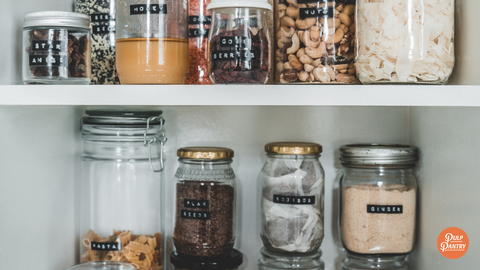
Guest Post by Olivia Wilson

Some zero waste hacks seem to appear everywhere you look, from bringing your own grocery bags to swapping to reusable water bottles. While we love how widespread these eco swaps are becoming (the more people aware, the better!), you may be looking for some fresh ideas. Below are a few of our favorite zero waste hacks that commonly get overlooked.
Borrow Instead of Buy
Try borrowing or renting items you only use once or twice a year. This allows you to skip the excess packaging, and you won’t have the item cluttering your home while it isn’t in use. While the idea of borrowing often brings libraries to mind—which are still highly recommended to reduce book waste—you can rent almost anything nowadays.
Items to consider include:
-
Novelty shaped cake pans from a bakeshop
-
Power tools from a home hardware store
-
Event decorations from a party supply store
-
Sports equipment from a library (where available) or a sport shop
-
Electronics, apparel, and other miscellaneous items from websites like Loanables
Don’t forget, friends and family are also a great source to borrow items. And it won’t cost you anything! Just be prepared to return the favor.
Know What’s in Your Fridge
It is estimated by the Food and Agriculture Organization (FAO) that 45% of all fruits and vegetables end up as food waste and that 95% of America’s food waste ends up in the landfill. This is an issue not only for landfill space and a waste of resources used to grow that food, but when placed in a landfill, food releases the potent greenhouse gas methane as it decomposes. Luckily, you can do your part to prevent food waste by keeping track of what’s in your fridge. To do so, try keeping your fridge organized so everything can easily be seen. Having designated spots for particular food can undoubtedly assist with this.
You may also want to put an “eat first” bin in the front of your fridge for food close to expiring. This will remind you that it needs to get used first and means it won’t accidentally get pushed to the back of the fridge and forgotten.
Need to figure out what to cook with ingredients on the brink of spoiling? Try a fridge clean out recipe or use an online recipe generator. An online recipe generator, such as Super Cook and Cookipedia, recommends recipes when you type in the ingredients you have on hand.
Combat Vampire Power
You don’t need a crime-fighting costume for this one (unless you want one) but rather some mindfulness and maybe a power strip or two. “Vampire power”, also known as standby power, refers to the energy that plugged in electronics draw while turned off or in standby mode—which can account for up to 25% of all energy usage according to a study by the Natural Resources Defense Council. The good news is we can slay vampire power by unplugging electronics when they aren’t in use or using a power strip. The power strip method is excellent since it is much easier to flip a switch than remembering to unplug each electronic individually. Plus, it also makes it easy to turn them back on later.
Buying a new electronic? Look for products that are Energy Star certified. This certification guarantees that a product meets government criteria for low power consumption.
Hold a Clothing Swap
If you are itching for a wardrobe refresh, you don’t have to go without to stay in line with your zero waste goals! Try hosting a clothing swap. Not only will you be able to get new clothing, but your unwanted and unused clothes can get a new lease on life. As a bonus, this method is also a lot of fun and an excellent way to bond among friends or your community.
Can’t meet in-person? Try a virtual clothing swap.
-
Create a private group on Facebook.
-
Write out the rules and make sure everyone can see them (minimum number of clothes someone has to offer, condition of clothing, how drop off or pick up will work, etc.).
-
Invite friends.
-
Get everyone to upload photos of the items they will be swapping into an album.
-
Once everything is uploaded and the swap begins, you may want to operate as:
First come, first serve: Whoever comments on the photo first gets that item. Be sure to designate an exact time to start with this method and limit how much clothing someone can claim. Generally, the rule is that participants can only claim as many clothing articles as they offer.
A clothing draft: Pick in order, one article at a time, similar to how a sport’s draft works. You can decide the order by drawing names at random and then continue in order with picks until there is no clothing left or nothing else is wanted. Assigning a time limit to each selection (2-5 minutes) can keep things flowing at a good pace.
-
Optional: Get everyone to drop the clothes off at your house, sort them by who the new owner will be, then do drop off or arrange pickup.
Note that this type of swap also works great with books and toys!
Go High Quality
Whether you are buying clothing, furniture, or a few zero waste kitchen tools, aim for quality. Well-made, quality items benefit zero waste since they have an increased lifespan, which keeps them out of the garbage due to wear and tear or malfunction. Remember, it may be more expensive initially but you will save money over time since it will last longer and you won’t be re-purchasing.
How do you pick high quality? Look for items with more durable fibers or components. For example, small-batch clothing tends to be better mended than mass-produced, and cast iron frying pans outlive most non-stick varieties. The key here is doing a little bit of research before you buy. Try reading reviews, getting a better understanding of the durability of various materials, and asking friends and family for their experiences with products they own.
Looking for more ways to advance your zero waste journey? Try answering the question: What is Zero Waste? Understanding exactly what you’re striving for can aid you in identifying problem areas within your home and lifestyle, as well as brainstorm potential solutions. After all, no zero waste journey is the same, so tailoring yours toward your specific needs is a great way to support the long-term success of your eco-efforts!





